All the places I visited during my trip to South Korea were amazing: Beautiful, interesting, rich in culture and delicious food. However, if I had to pick one apart from Seoul that under no circumstances you ought to miss out on, without a doubt, it would be Gyeongju. Gyeongju has so much cultural heritage and so many archaeological sites that the city rightfully bears the nickname Museum Without Walls. But during my two days in Gyeongju, I wasn’t only looking back at a thousand years of Imperial History. The so-called Golden City is also a major center of the country’s artisan bakeries and belongs on every true connoisseur’s itinerary.

The Golden City
Gyeongju, today nicknamed the Golden City, was the capital of the ancient Korean empire of Silla from 57 BC to 935 AD. At its peak, the city probably had up to a million inhabitants. The kingdom ruled most of the Korean peninsula after King Munmu conquered the neighboring kingdoms of Goguryeo and Baekje in the seventh century, unifying the country under one empire for the first time.
Since he wanted to protect his country from Japanese pirates after his death as a sea dragon, he ordered to bury his ashes in the ocean. His grave is said to lie among several rocks off the coast east of Gyeongju. However, according to legend, the grave of his faithful wife lies further south off the coast of Ulsan. This so-called Daewangam Rock is a lovely day trip destination, I introduced it in detail in my post Why the City of ULSAN is Absolutely Worth a Visit.
In and around Gyeongju are numerous grassy hilltops up to 25 meters high. For the longest time, it was assumed they were simple geologic elevations. In reality, these are burial mounds of the Kings and other dignitaries of the Silla Empire. They are actually comparable to the pyramids in which Egyptian aristocrats were laid to rest together with their valuable burial gifts.
Museum Without Walls
The first royal tombs were only opened in the 1920s. In the year 2000, UNESCO listed Gyeongju’s historical sites as one of the World Heritages. This includes five separate yet historically connected areas in the city center as well as the suburbs.
Hence, Gyeongju is called a Museum Without Walls for good reason as the number of historical treasures is simply overwhelming. In addition, there are also more recently created attractions such as various museums, gardens, and amusement parks. To visit everything worth seeing, you should plan at least a week for Gyeongju. As I only had three weeks for my entire Korean trip, I limited my stay to two full days.
Don’t You Miss It
Interestingly, I would roughly divide Gyeongju’s visitors into two major categories: Fun-loving, voracious Asians – primarily Koreans – for whom the countless historical sites seem to serve almost exclusively as background for their Instagram photos. And then there are the serious, education-hungry, ambitious Europeans who only reward themselves with a small fat-free ice cream after a grand tour of all the sites.
Typically, I tend to go culture hunting according to my European roots. But after almost two weeks in Korea, I chose a mix of the best of both worlds.

I visited the royal tombs, which are easily accessible in the center of the old town of Gyeoungu. However, I refrained from venturing into the outskirts just to see more green hills. Honestly, if you’re not a historian specializing in Korean yore, then all the tumuli look the same. Yes, under one are the remains of the first Silla King Bak Hyeokgeose, under another one, King Michu rests in peace.
Interesting? Sure!
Worth taking an hour on the bus for more of this? Nope, not for me.
I’d rather take some time for a long coffee break in one of the pretty, lavishly decorated coffee houses, try exotic ice cream flavors, stroll between original boutiques, and indulge in other forms of hedonism.
I experienced the historic center of Gyeongju as a perfectly balanced mixture of an ambitious educational trip and a fun-loving land of milk and honey.
My post gives you the recipe for this delicious blend.
Daereungwon Tomb Complex
Say what you will, Daerungwon Tumuli Park is Gyeongju’s main attraction. It is a park which consists of 23 burial mounds. The tombs are the final resting places of Kings and other prominent figures of the Silla Empire and are connected by footpaths. Obviously, the complex is part of Gyeongju’s UNESCO World Heritage Site.

With an area of around 80 by 120 meters, the double mounds of the Hwangnam Daechong Tomb are the largest among those tumuli. It is the final resting place of a royal couple who were buried with over 30,000 relics, among them a crown made of gold and jade.
You can get a clear idea of the structure of the tombs at the so-called Tomb of the Heavenly Horse Cheonmachong which has an entrance so that you can visit the interior. Apart from the archeological site, there are also replicas of the items found in the grave. All original finds, however, are in the National Museum.

The fenced part of the complex can be visited every day from 9 a.m. to 10 p.m. for KR₩ 3,000.
By the way, the funniest myth surrounds the tomb of King Michu, the 13th king of Silla: When the Japanese invaded the empire during the reign of Yurye, according to legend, soldiers with bamboo leaves in their ears came out of the tomb and defeated the invaders.
Below, I’m introducing only three of the many interesting tumuli in detail. If I listed all of them, we would be here all day – and we want to visit also other mesmerizing sites, don’t we?
Geumgwanchong
The Geumgwanchong, Gold Crown Tomb in English, is believed to date from the sixth century based on the tomb’s structure and Buddhist influence. Obviously, this was even before the Silla period.

When it was opened in 1921, it was the first tomb in which a gold crown of the Silla royal family was found. To this date, it is still the largest crown that was recovered. In addition, the tomb contained an incredible number of 40,000 other artifacts. These included vessels made of various precious metals and stoneware, valuable weapons, gilded bronze plate armor, and 20,000 mostly blue Indo-Pacific beads.
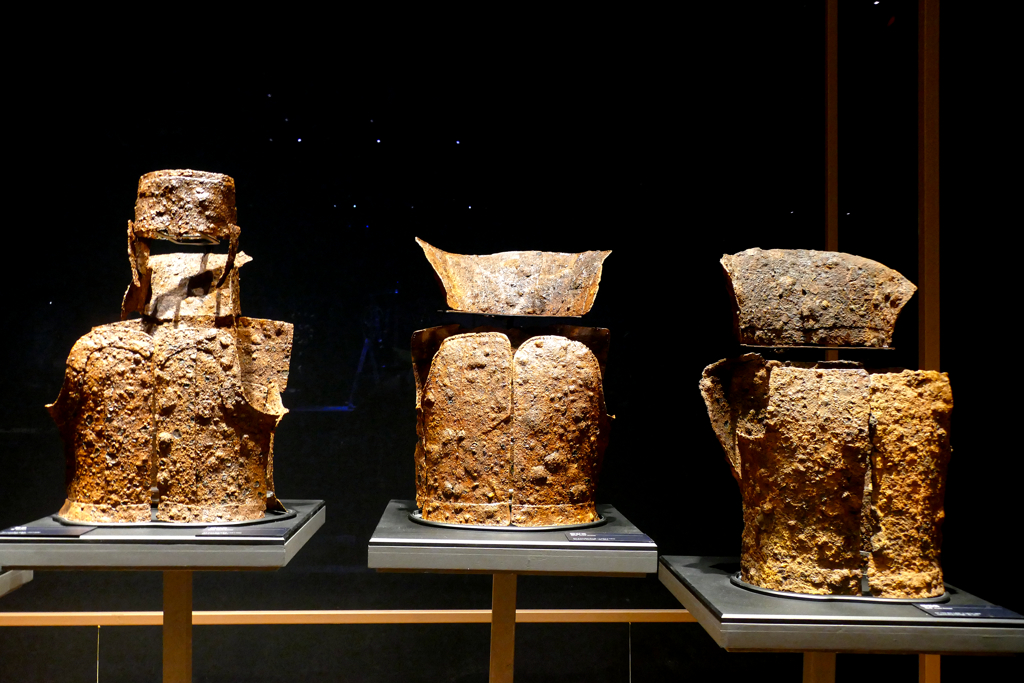
During the excavations, other large tombs such as Geumryungchong and Seabongchong were discovered.
Cheonmachong
The Cheonmachong is right next to Geumgwanchong. Loosely translated, the name means Tomb of the Heavenly Horse. It is the burial site of an unidentified person and probably also dates from the early 6th century.

When archaeologists opened the grave in 1973, they encountered over 12,000 artifacts including a gold crown and many other pieces of jewelry. They also discovered a picture of a galloping horse that gave the grave its name. It is the only known painting from the Silla Kingdom period.
The inside of the Cheonmachong tumulus can be visited every day from 9 a.m. It’s very interesting to get to see the structure, and you’ll spot replicas of the grave finds. The originals are of course safely stored in the National Museum.
Royal Tomb of King Michu
I’ve already told the crazy story mythology surrounding King Michu’s grave above. From 262 to 284, Michu Isageum was the 13th ruler of the Kingdom of Silla. He was also the founder of the Kim dynasty, from which a total of 38 rulers of Silla emerged.
During his term, Michu repelled the invasion of Baekje and promoted extensive agriculture.

Michu’s tomb is located in the southern part of the Daereungwon complex. It was subject to archaeological excavations in 1974. Archaeologists found, among other things, an unusually shaped golden sword. Its decorations are more Western in style and thus suggest cultural exchange with Europe or Central Asia already at that time. But also a valuable ceramic vessel decorated with small figures comes from Michu’s grave.
Cheomseongdae Observatory
The Gyeongju Eastern Historic Site, also known as the Wolseong district, is a blanket term for the area southeast of the Daereungwon Tomb Complex. Here, you’ll find various significant historic sites dating back to the Silla Period.

The most famous relict is undoubtedly the Cheomseongdae Observatory. It is the oldest observatory in all of East Asia. The stone tower was finished in the year 646.
Cheomseongdae represents the structure of time in a well-thought-out way: The 12 stones of its foundation represent the 12 months. There is a total of 30 layers on this base, each representing a day of the month. And the fact that the column is made up of 366 stones symbolizes each day of the year, obviously.

The tower is just over 9 meters tall and has a diameter of 5.17 meters at the top and 5.35 meters at the bottom.
After the Cheomseongdae Observatory was declared a national treasure in 1962, it was added to the UNESCO World Heritage List in 2000 along with other historical sites in Gyeongju.
Especially after dark, when the observatory is illuminated in bright colors, it is a popular place for families, lovers, and entire groups to have their photos taken in front of it.
Gyochon Village
West of the Wolseong elevations is the traditional Gyochon Village. Just like the Hanok Folk Village in Jeonju, Gyochon Village is another time-honored district with ancient Hanok houses that offers visitors a glimpse of life during the Joseon period. But since there is so much to see in Gyeongju with the city’s countless royal tombs, the enchanting Wolji Pond, the magnificent museum complex, and of course the streets lined with incredible cafés, the tourist crowds spread out and are not as crammed as in Jeonju. As there is a lot less going on in the Gyochon Village, you can enjoy the beautiful architecture and atmosphere in a much more relaxed way.

One of the most famous sites here is the Gyeongju Hyanggyo, a Confucian academy and shrine where Korea’s first state educational institute, Gukhak, was founded in 682.
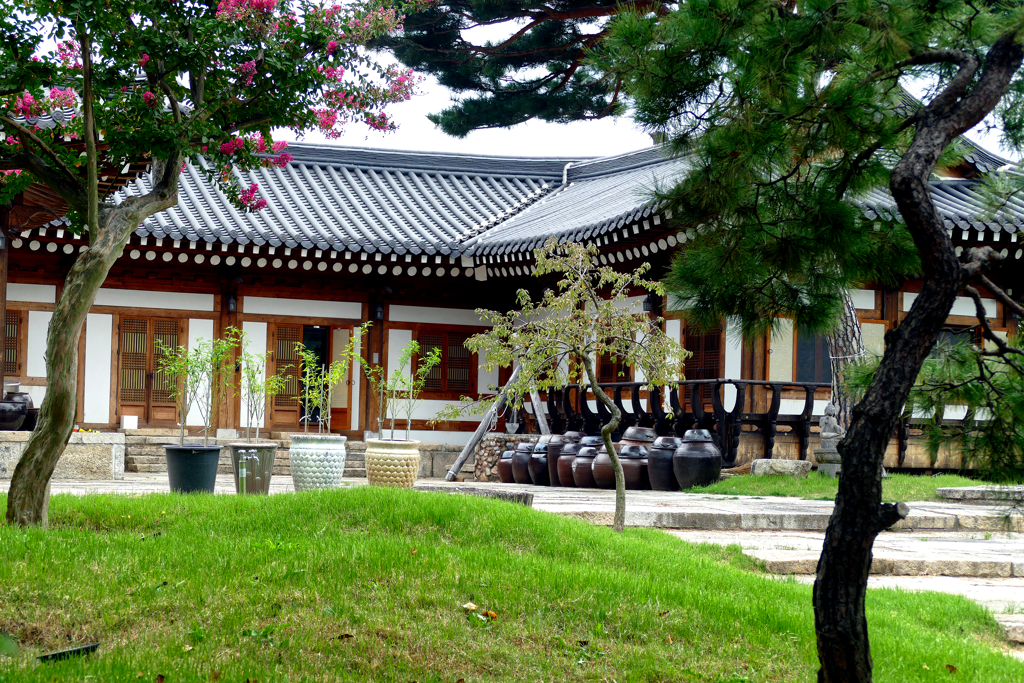
The village is also known for being home to the Gyeongju Choe clan for twelve generations. The ancestors built a huge mansion in the traditional Hanok style. The size of the house came sharply to the maximum limit allowed for commoners’ houses during the Joseon period. Although they were the richest landowners in the region, the Choe clan was widely respected due to their community spirit and generosity towards their poorer neighbors.
Woljeong Bridge
Just on the outskirts of Gyochon Village, the Woljeong Bridge spans across the former palace moat. The bridge’s symmetrical structure is exceptionally captivating. It was built of wood by King Gyeongdeok during the Silla period and burned down during the Joseon Dynasty. Only the foundation walls remained of the original bridge.
Based on historical research and appropriate specifications, the bridge was converted into the largest wooden bridge in Korea in 2018.
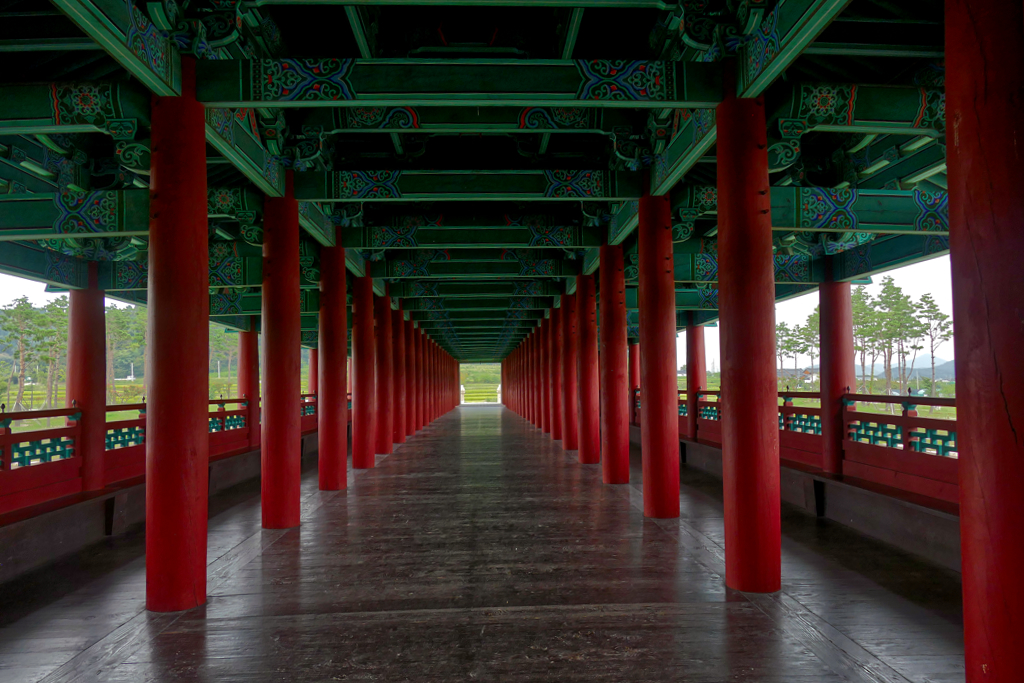
The bridge is open daily from 9 a.m. until 10 p.m. open. At the north-facing end, you can climb a steep staircase to the upper floor. Since I was expecting to be able to take great panoramic shots from there, I was very disappointed that all the windows were closed – so the climb wasn’t worth it.
Donggung Palace and Wolji Pond
On the opposite side of Wolseong and across the main road Wonhwa-ro is one of Gyeongju’s most glittering gems, the Donggung Palace at the Wolji Pond.
The Wolji, in English the Pond in Which the Moon is Reflected, is an artificial lake in an old part of a palace complex. Munmu, the 30th king of Silla, commissioned the pond in 674. In the middle of the oval water are three small islands. If you look at the small peninsula in the lake as an image of Korea, the three small islands should represent Kyushu, Jejudo, and Taiwan.

In 935, a fire destroyed the five pavilions, the remains of which sank into the pond. It was not until 1975 that the lake was drained and the remains of the buildings were recovered. Three of the pavilions were then rebuilt.

730 of the 33,000 artifacts also found in the pond are exhibited in the National Museum. These include everyday objects such as jugs and roof tiles, but also valuable jewelry and bronze figures of Buddha.
Beauty at Day And Night
The complex is open to visitors from 9 a.m. to 10 p.m. As with all historical sites in Korea, the entrance fee is pretty cheap at just KR₩ 3,000.
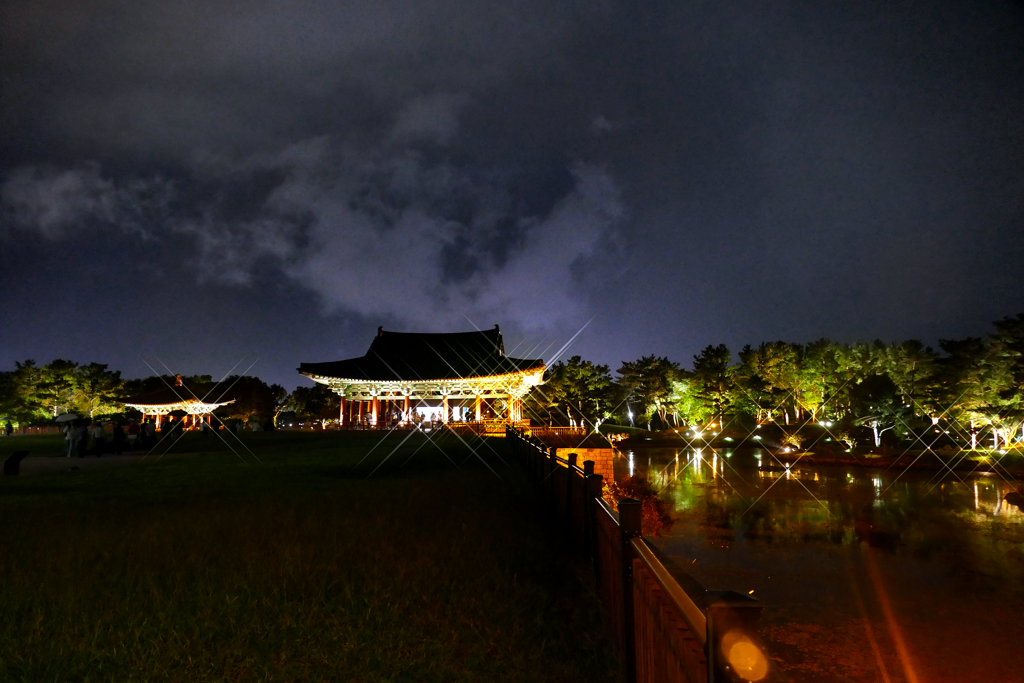
I timed my visit to the Sky Deck of the Lotte Tower in Seoul in a way that I had still sunlight in the late afternoon and then had to wait a while for sunset and finally darkness. The entry price of KR₩ 29,000 was worth the wait.

At the Wolji pond with its entrance fee equivalent to around US$ 2, I treated myself to entering the complex twice: First, I was there in the afternoon, and after dinner, I came back to marvel at the complex once again after dark, then bathed in golden light.
Lotus Complex
North of the pond is a freely accessible area covered with lotus. Unfortunately, lotus is a summer flower with an extremely short blooming period from late July to early August.
But that is also the time when Korea is usually paralyzed by stifling heat waves.

Hence, although lotus fields in full bloom are a mesmerizing sight, you might want to think twice about whether it’s worth it to come to Korea during the most brutal period.
Gyeongju National Museum
The National Museum is located just southeast of the center. The complex consists of four exhibition halls showing finds from the Silla Kingdom period.
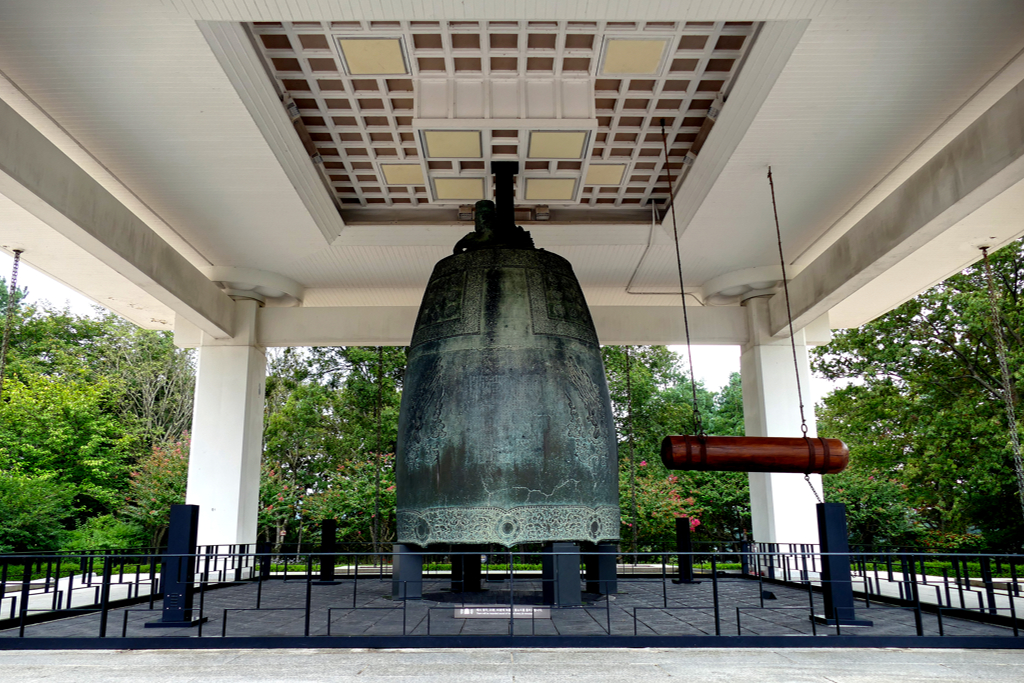
Opposite the main entrance is a pavilion housing a sacred bell dedicated to King Seongdeok. It is one of the largest Asian temple bells. Construction began under Seongdeok’s son, King Gyeongdeok, the 35th King of Silla.
The bell is also known as the Emile bell due to an ancient legend that a child was sacrificed to give it its sound. This supposedly chimes like em-ee-leh, the Korean word for mommy.
The tubular sound tube at the top of the bell is a feature unique to Korean bells. Therefore, if you punch the bell only with your fist, its clear sound is heard within around three kilometers! You will never be able to verify it because it is of course strictly forbidden to even touch the bell, which is listed as a national treasure.

Another showpiece is the golden Geumgwanchong Crown. There are also finds from the Cheonmachong grave such as a lavishly decorated gold belt and a golden hat.

Furthermore, beautiful ceramic works from the Silla period are on display. The Yongmyosa ceramic roof tile depicting a human face even became an icon for the entire region.

Entry to the museum is free, you can visit it from 9 to 6 on weekdays, and it doesn’t close until 7 on weekends.
Bulguksa Tempel
Bulguksa Temple, located about 16 kilometers southeast of the center, is one of the most famous temples in Korea. Completed in 774, it is considered a masterpiece of the heyday of Buddhist art in the Silla Kingdom. It is home to seven national treasures of South Korea and was listed as a World Heritage Site by UNESCO in 1995. It was completely destroyed during the Imjin War at the end of the 16th century and was only reconstructed between 1969 and 1973. The stone structures are remnants of the original building.

The temple is spread over several terraces.
The former main entrance to the temple complex led via a two-part staircase through the Gate of the Purple Mist to the large temple courtyard. The staircase dates back to the eighth century and is a special treasure. The lower part, the so-called Bridge of Blue Clouds, has 17 steps while the upper part has only 16 steps and is called the Bridge of White Clouds.

In the middle of the large temple courtyard stands the Hall of Great Enlightenment, which is, however, a modern reconstruction of the completely destroyed former building.

For KR₩ 5,000, you can visit the temple every day between 7 a.m. and 6 p.m. In winter, hence from November to January, they open only at 7.30 a.m. and close already at 5 p.m.

There is a regular and frequent service from Gyeongju’s city center to Bulguksa by various city buses. The Naver App will show you the most convenient one according to your itinerary.
Seokguram Grotto
Seokguram is located on Mount Tohamsan, four kilometers above Bulguksa. The grotto was completed in 774. Inside is a white statue of Shakyamuni Buddha who oversees the surrounding area all the way to the Sea of Japan. In fact, this sanctuary was long forgotten and was only rediscovered in 1909. Then, restoration began.

The three chambers of the artificial grotto are carved from granite blocks. The layout follows a well-thought-out, metaphysical concept. A rectangular vestibule and a narrow corridor lead to an inner circular main room with a dome.
The rectangular anteroom and the narrow corridor symbolize the earthly and serve to protect the inner sanctuary. The centric round chamber symbolizes the kingdom of heaven. In the center of the sanctuary, the Buddha sits on a lotus throne.

Seokguram is of course also a Korean national treasure and was added to the UNESCO World Cultural and Natural Heritage List in 1995 along with Bulguksa.
Buses run every hour from the Bulguksas car park and the stop below the temple to Seokguram. The journey only takes about 15 minutes. Then, you have to walk uphill for a few hundred meters through a forest.

There is also a hiking trail just over three kilometers long between the two sites.
Hwangnidan-gil
Indeed, Gyeongju is mainly famous for its culture and rich heritage. But as I pointed out above, the city is also widely known for culinary pleasures. While bakeries and cafés and ice cream parlors and the like are found everywhere in the city, the highest concentration is alongside Hwangnidan-gil and its side alleys.
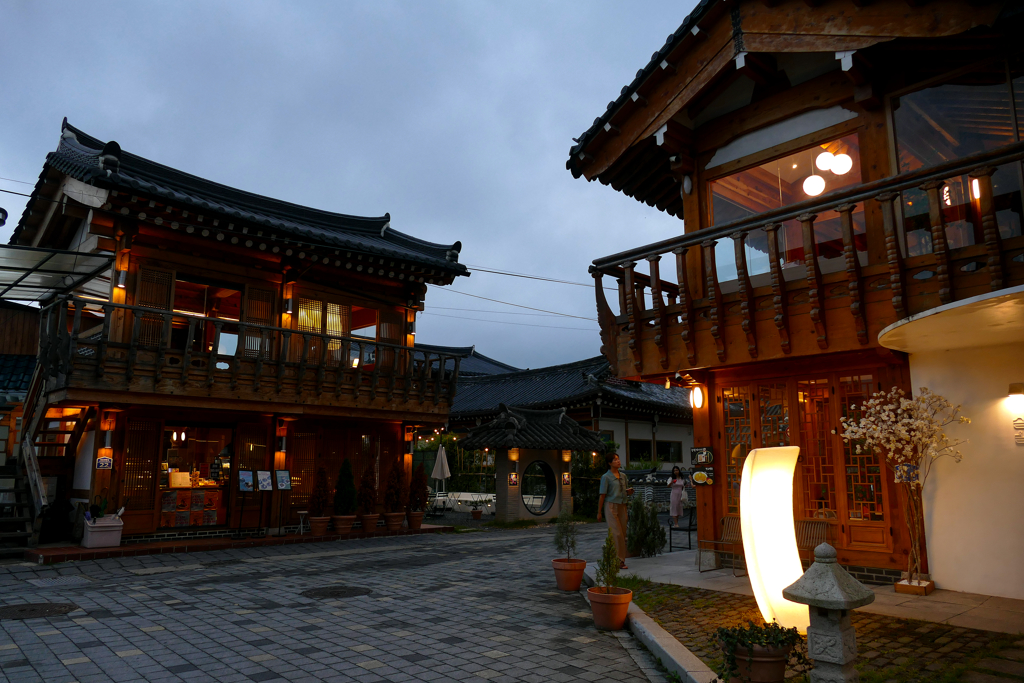
This street is brimming with traditional architecture, and all these amazing Hanoks are housing quirky shops, elegant boutiques, and trendy cafés and eateries. Let me just quickly introduce my favorite
Coffee Houses
Yangji Dabang – the Most Alluring One
Yangji Dabang enchants with its charming retro decor. In a remodeled old house, you only travel back to the 1970s and 80s in the front area, but in the back area, it becomes very nostalgic: ornate armchairs and sofas like in grandma’s living room, fake Tiffany lamps and the good china granny reserved exclusively for visitors is taken from the cupboard.

In addition to a cozy atmosphere and very good coffee, you can enjoy excellent desserts such as Soufflé pancakes at Yangji Dabang. At around KR₩ 15,000, they cost as much as a full meal, but are just as filling.
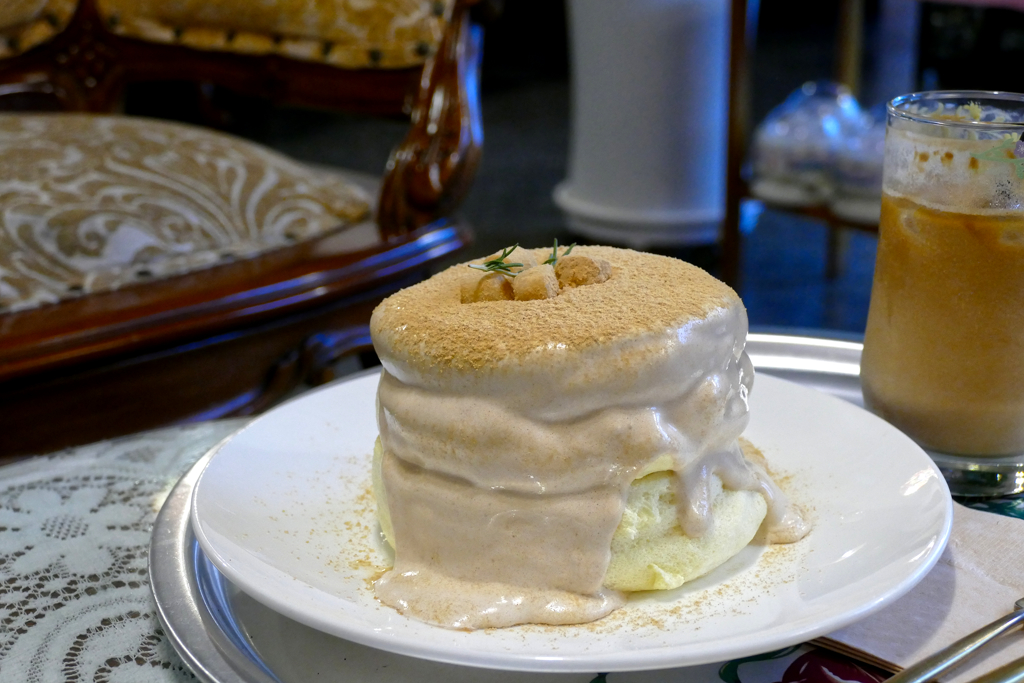
Yangji Dabang is located at 7-2 Sajeong-ro 57beon-gil and serves its delicacies every day from 11 a.m. to 8 p.m.
Hwangnam Darak – the Hidden One
A truly concealed gem is the Hwangnam Attic. Not only is it located on a hidden side street, it is also housed in an inconspicuous residential building. But don’t be shy and come in!

Even inside, you won’t be able to avoid the impression that you’re staying with friendly neighbors you’ve never seen before. The rooms are furnished in a trendy shabby chic style.

In 7-6, Sonhyoja-gil, every day from 10.30 a.m. to 10 p.m., excellent coffee and delicacies for those with a sweet tooth are served.
Stay 550 – the Luxurious One
Stay550 is a chain. Hey, don’t turn up your nose just yet, because Stay550 is a top-notch bakery where you can buy freshly baked bread, incredible cakes, and other desserts every day. Of course, it’s best when you enjoy them together with a coffee made from their artisan coffee beans on-site in a relaxed and slightly hip atmosphere.
Due to its reliable quality, Stay550 has a loyal following among Koreans.

There are two branches in Daegu, one in Gumi, and of course one in Gyeongju, which you can visit at 56-1 Sajeong-ro.
The café is open every day from 10 a.m. and closes from Monday to Thursday at 9:00 p.m., Fridays and Sundays at 10:00 p.m., and on Saturdays even at 11 p.m.
Munjeongheon – the Mystic One
I came across Munjeongheon by pure chance. If they hadn’t posted their very reasonable price for coffee on a board outside, I wouldn’t have even thought that the traditional little house on a very private-looking property was a public place. Just walk in – but only after you take off your shoes at the door. After all, it is a classic Korean establishment.

Inside you can sit in an enchanting atmosphere between high bookshelves either at tables or on cushions at low tea tables.
Munjeongheon is a real oasis and has nothing in common with quickly consumed coffee to go apart from the drink as such. It is located in a garden at 751 Taejong-ro and is open daily from 10 a.m. until 9 p.m.
You’ll find charming bookstores and exceptional cafés all over Korea. I presented glorious examples in my posts Best And Most Beautiful Bookstores in Seoul and 7 Best And Most Beautiful Coffee Houses in Busan.
Street Art
In contrast to many other Korean cities such as Seoul, Busan, Jeonju, and Andong, Gyeongju has no so-called Culture Village, hence, a neighborhood that had to be improved with murals. Nevertheless, the 7th World Water Forum entitled Water for Our Future took place in 2015.

While the scientific panels and technology events took place in Daegu, a city about 60 kilometers west of Gyeongju, the latter was in charge of the political and regional programs and the citizens’ forums.

Complementing the official programs, there were various cultural events such as concerts and film festivals around the venues taking place in both cities.

To this date, the alleys north of the Historic Wolseong District show beautiful and profound murals that marked the occasion.
A hidden gem that’s definitely worth the detour!
Practical Information
How to Get There
Train
Ever since Singyeongju station replaced Gyeongju’s old railway station on the outskirts of the historic center, it has been officially called Gyeongju Station. This is where the fast trains from Seoul as well as from Busan arrive. Then, you’ll need to take city bus #700 to the city center.
You can buy tickets at the railway station from vending machines as well as real people and supposedly on the internet. Nevertheless, some fellow travellers told me that they couldn’t pay with their international credit cards. I don’t know since I always bought my tickets before departure at the station.
For the sake of completeness, it should be mentioned that tourists can also obtain the KORAIL Pass. However, I cannot even imagine how much time you have to spend on those trains to get your money’s worth out of them. The cheapest pass costs KR₩ 121,000 for two consecutive days. In comparison, I paid KR₩ 21,000 for a KTX ticket all the way from Andong to Seoul.
Bus
Since I had booked a hotel that was a five-minute walk from the bus terminal and I was coming from Ulsan, I preferred to travel by bus – as I often did on my travels through Korea. As a matter of fact, I took the train only twice during my entire trip.
For travel between cities, towns, and villages, so-called Express and Intercity buses are a great option. They are fast, clean, and comfortable. Fares vary a bit depending on the bus type and the time of the day. However, in comparison with other countries, they are always rather cheap. I always paid KR₩ 10,000 to KR₩ 15,000 for four-hour trips. You can buy tickets right at the bus terminals from vending machines or very helpful clerks.
Obviously, Gyeongju is well-connected to many other cities on the east coast. Also, the Bus Terminal is just a short walk west of the historic center.
How to Get Around
Just like everywhere in South Korea, inner-city transport in Gyeongju is perfect! Although they have no subway, there is a comprehensive and reliable bus net also serving the landmarks on the outskirts.
A single trip costs between KR₩ 1,100 and KR₩ 1,400 depending on the distance. Also, you save a bit if you pay with a T-money card.
Obviously, the city center is best explored by walking or cycling. The outskirts, however, are hilly and even mountainous so walking or cycling is only for the sports enthusiasts among you.
Some guesthouses offer rental bikes for their guests for free or at a small charge. If yours doesn’t, Gyeongju Express Scooter & Bicycle Rental next to the Express Bus Terminal is a great place to rent a set of wheels.
Note that Gyeongju has designed six bicycle routes with different themes, levels of difficulty, and lengths. You can pick up a free bicycle map at the tourist office downtown.
Visiting Organized
Although I’m an avid solo-travelling woman, I sometimes like to join organized tours. Especially in a place as rich in history as Gyeongju, joining a tour with a knowledgeable guide will make so much more of your visit.
Therefore, here are some great ideas of what to do when visiting Gyeongju. Especially during high season, pre-booking online will guarantee your place at the activity of your choice*:
Where to Stay
The more I traveled through Korea, the more I experienced how much women are underdogs. It was very clear that I was not given the same respect as a man. It starts with the fact that the saunas in hotels are exclusively reserved for men. However, women do not pay less for the room in return. As I asked at the GG Hotel* for a breakfast reservation, the receptionist first nodded eagerly. When she saw on her computer which room I had and that I stayed there alone, a breakfast reservation was suddenly impossible. As I asked if it was because I was alone as a woman, she answered rather evasively. Finally, she claimed it was because the cook was having a bereavement. I didn’t insist any longer and let it go. Her lie was just too ridiculous. After all, other guests were not denied breakfast.

However, below I will show you that it is better to start the day in one of the many cozy and beautifully decorated cafés, anyway.
Despite the subtle discrimination against women, which sadly is rather a Korean standard, I do recommend the GG Hotel*. Mainly because it is approximately a five-minute walk from the bus stations. Also, you will be at Daereungwon Tomb Complex and Hwangnidan-gil Street in only around ten minutes.
The rooms and bathrooms are spacious and equipped with everything you need. For the price, you will hardly find a better lodging option.
However, if you prefer other accommodation, for example in a converted traditional Hanok, then you will find a suitable option on this map*:
What to Eat
A popular snack – and the perfect souvenir – are small cakes from Gyeongju. There are two varieties. Hwangnam bread, also known as Gyeongju bread, consists of a soft dough with a sweet bean paste filling. A chrysanthemum is often embossed on the top. The other type looks like two small pancakes with the same sweet paste in between. There are numerous stores that sell these cakes in multipacks. Most of the time you can watch the bakers behind the counter preparing these little desserts.

If you like sweet things for breakfast, Hwangnam bread is certainly an excellent option.
Another local specialty is the 10 ₩on Bread, which comes actually in the shape of a 10 ₩on coin. It is filled with a generous amount of mozzarella and is sold on a stick. Be a little careful when eating it for the first time, because the cheese can be quite hot – and it forms long – very long – strings.

The 10 Won Bakery in Gyeongju specializes in this delicacy. As a matter of fact, they only have this one dish on their menu. Nope, they don’t charge 10 ₩on for their bread but actually KR₩ 3,000 which is absolutely reasonable for such a delicious snack.
Ssambap
Ssambap is a dish consisting of minced steak, fish, rice, and Banchan, many different side dishes. These are then eaten in bite-sized pieces wrapped in lettuce leaves of your choice. Gyeongju Ssambap is particularly known for its fresh and aromatic ingredients. I didn’t want to miss this.

Here I had to experience once again that it is disadvantageous to travel to Korea alone. Due to its structures and traditions, the country is simply not culturally prepared for loners: I had to forego the Korean barbecue because it is only served for two people or more. But in Gyeongju, I have also been turned away from many a restaurant door because I only ordered Ssambap for one person. I frankly felt treated like a pariah. Korea’s tourist facilities could indeed become a little more flexible and adapt to international demographic figures, especially since Korea’s government has declared 2023 and 2024 the Visit Korea Year.
This being said, I am happy to announce that after a long search, I found a restaurant that was willing to feed also a solo traveller.
Banchan
Banchan are the most important staple of Korean cuisine. They are a variety of different vegetable dishes served in small bowls. Those are placed in the middle of the table for everyone to enjoy. In some restaurants, you can choose the Banchan you like from an open buffet.
The most famous Banchan is probably Kimchi. Kimchi is fermented vegetables – traditionally Chinese cabbage and Korean radish. Together with rice and a light soup, Kimchi is an essential part of practically every meal in Korea.
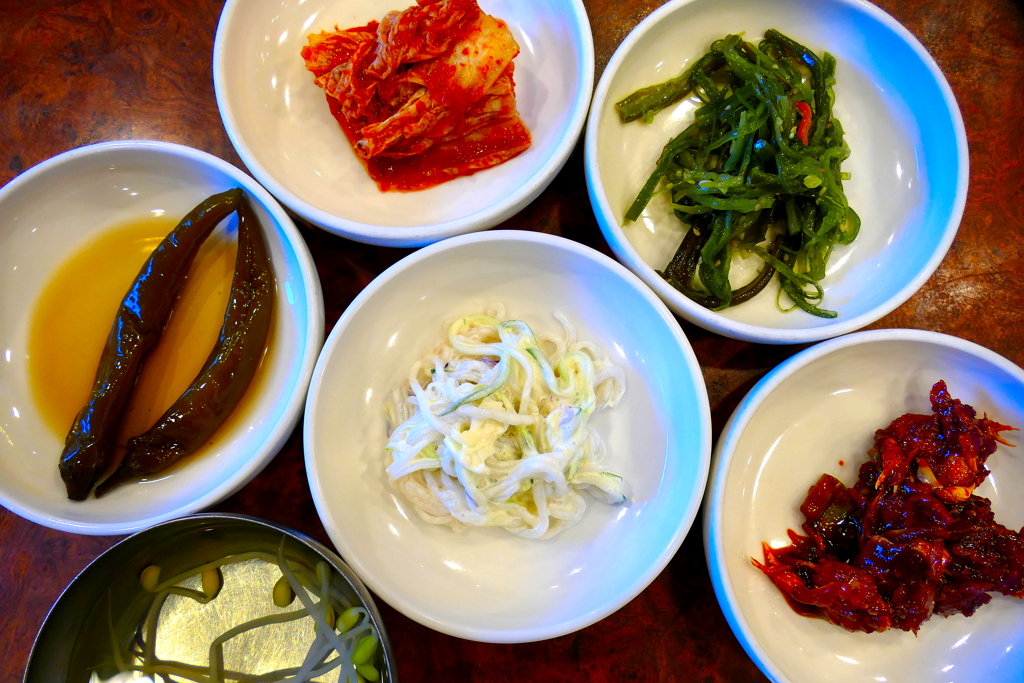
As basically all types of vegetables can be fermented, additional types of kimchi have emerged. Apart from cabbage and radish, you’ll be served also cucumbers, leeks, and some local roots. In 2013, Gimjang, the traditional process of preparation and preservation of Kimchi, was added to the UNESCO list of Intangible Cultural Heritage.
Fun Fact:
12 different kinds of Banchan were the standard at the Royal court
Cash And Cards
The currency in Korea is called ₩on and abbreviated KR₩. There are bills of 1,000, 5,000, 10,000, and 50,000 and coins of 10, 100, and 500 ₩on.
As of August 2025, the exchange rate is 1,000 KR₩ = 0.72 US $ (current rate) respectively 1,000 KR₩ = 0.63 €uro (current rate).

Most of the time, you can pay with either cash or card in Korea. However, some businesses accept only cash while others take only cards. Although payment goes smoothly most of the time, you might encounter some hurdles here and there.
In Korea, they draw a not-so-fine line between local cards and international cards.
Therefore, it can happen that certain ATMs can read only cards issued in Korea. More importantly, you can get only money from ATMs that are suitable for so-called global credit cards.
Either way, I’d strongly recommend to have always at least a small amount of cash on you as international cards may decline for no apparent reason.
T-Money Card
A very Korean means of payment is the so-called T-Money Card. It’s basically a debit card that you have to purchase for an initial price of KR₩ 2,500. You can get the basic T-Money Card at any subway- and train station as well as at convenience stores around the country. However, you can get a free card for instance when buying a SIM Card*.
Eventually, you have to charge it with the amount of your choice either at a ticket vending machine or a convenience store. You can top-up the card in units of KR₩ 1,000 up to KR₩ 90,000 at a time. The total deposit cannot exceed KR₩ 500,000. It’s important to know that you cannot top-up by credit card, you have to use cash. Also, I’d recommend topping it up with smaller amounts in case you lose it.
If you don’t use up the credit on your card by the end of your trip, you get a refund at all retail locations. However, they won’t refund the initial price as well as an additional service fee of KR₩ 500.
As I needed both, a SIM card and T-money, I obtained a combined card through GetYourGuide* and picked it up at Incheon International Airport on arrival. Obviously, you can use the T-Money card even after the SIM card expires.
Connection and Communication
You can connect to the internet without any issue at basically every museum, eatery, café, and hotel, obviously, as well as to open Wi-Fi in many public areas.
As I depended so much on a reliable internet connection during my trip through Korea, I highly recommend getting your personal data either by a mobile router or a local SIM card. I kid you not, the few moments I for some reason didn’t have an internet connection, I felt like travelling blindfolded.
There are prepaid SIM cards by various companies such as KT Corporation, SK Telecom, and LG U+. I got my card from the latter and loved it. LG U+ offers SIM cards, eSIM, as well as portable Wi-Fi. My card came with a T-money card. I obtained it through GetYourGuide* and picked it up at Incheon International Airport on arrival. However, LG has stores all over Korea. For unlimited data, they charge between KR₩ 27,500 for 5 days and KR₩ 99,000 for 40 days. I had the 20 days-version for 60,500 ₩on*.
In South Korea, they use plug types C and F. Their voltage is 220 V, and the frequency is 60 Hz. Whereby, nowadays, in general, all these chargers have integrated adapters so that the voltage and frequency don’t really matter.
By the way, you’ll find this information and many more comprehensive travel tips in my post World’s Most Complete Travel Information – an indispensable globetrotter-classic.
Useful Apps
So now that you have internet, you might want to check out these helpful apps. Well, let me rephrase it: At least a smoothly working map and a translation app are not just helpful, they are actually indispensable!
Naver Map
It’s not correct that Google Maps doesn’t work in Korea at all. You can open the App and see where places are. However, it doesn’t give you useful information on public transport and it doesn’t suggest routes. Yet, it recognizes who you are: The blue dot. So while you can check where you are, you cannot plan out routes.
Fortunately, there are two other Apps in Korea, namely Kakao Map and Naver Map. Since I had tried out the latter and was happy with it, I stuck with it without giving Kakao Map a try.
How to Use It
As you can see in the pictures below, Naver works basically just like Google Maps: You type in from where to where you want to go, specify the date and hour, and choose the means of transportation. Then, Naver does the magic and suggests various options.
However, Naver tends to be patriotic and sometimes transcribes destinations into Hangul so you cannot check that it actually found the place you were looking for. I solved this problem by verifying Naver’s suggestion on Google Maps.



Also, Naver sometimes didn’t show any search results. For instance, if I wrote XYZ restaurant instead of restaurant XYZ. In these situations, I first looked it up on Google Maps, because like I said, it does work insofar as it finds places. Then, I searched for the spot right on Naver’s map. As I found it, I tapped on it on the screen and saved the result for future reference.
Register
I set up a free account to save search results. I organized them in folders, you can see them in the second picture.

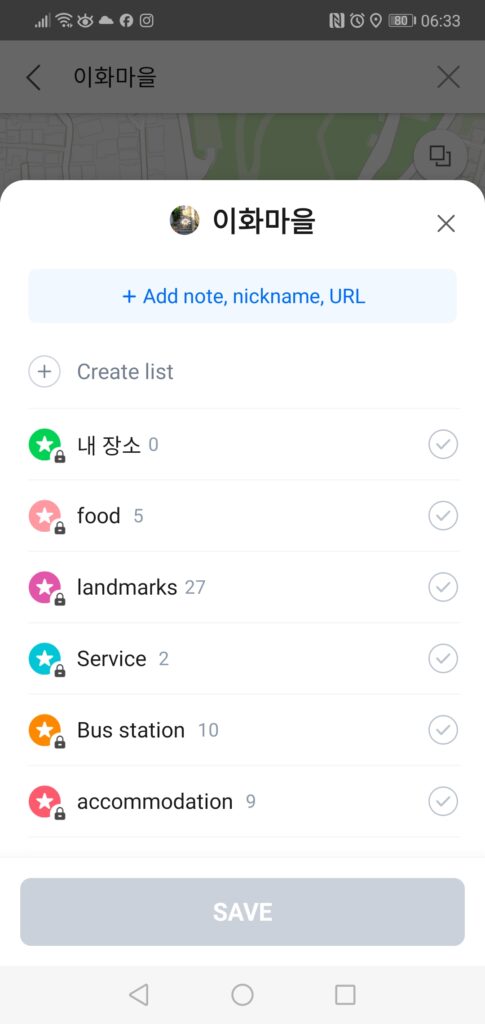

When Naver showed the result in Hangul, I wrote the Latin equivalent in the field for notes before saving. This way, I had the places once and for all in Roman letters, and they also appeared on the map. Eventually, I planned my routes by simply tapping on two marked spots on the map.
You can download the Naver App for Android and for iOS
Microsoft Translator or Naver Papago
Just like it’s a personal preference if you search your way with the help of Naver Map or Kakao Map, it’s totally up to you which translation App you’re using. And even if you don’t choose any of these, most Koreans do have a translator on their phone when they have to deal with foreigners on a regular basis.
For the same reason I chose Naver Map over Kakao Map, I stuck with the Microsoft Translator: I downloaded it first and was happy with it – hence, never change a winning team.
However, both translation Apps offer the same kind of assistance: You can speak, write, or take a picture of a script and the App will translate it.

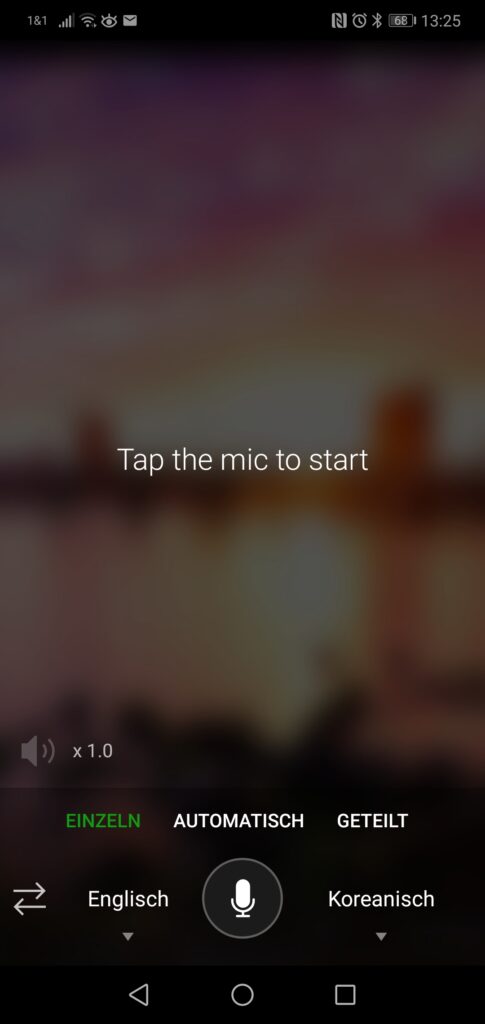

You can download the Microsoft Translator for Android and iOS.
Map
On this map, you can spot where all the mesmerizing places I’m introducing in this post are located.
Clicking on the slider symbol at the top left or the full-screen icon at the top right will display the whole map including the legend.
Gyeongju was only one of many amazing places I visited during my road trip through South Korea. To read about the others, go to the main post and take your pick! There, you’ll also find further valuable general information that will make your trip smoother and much more enjoyable. Also, make sure to read my post Individual Solo Trip to KOREA – All Your Questions Answered before you start your planning’n’packing!
Pinnable Pictures
If you choose to pin this post, please use one of these pictures



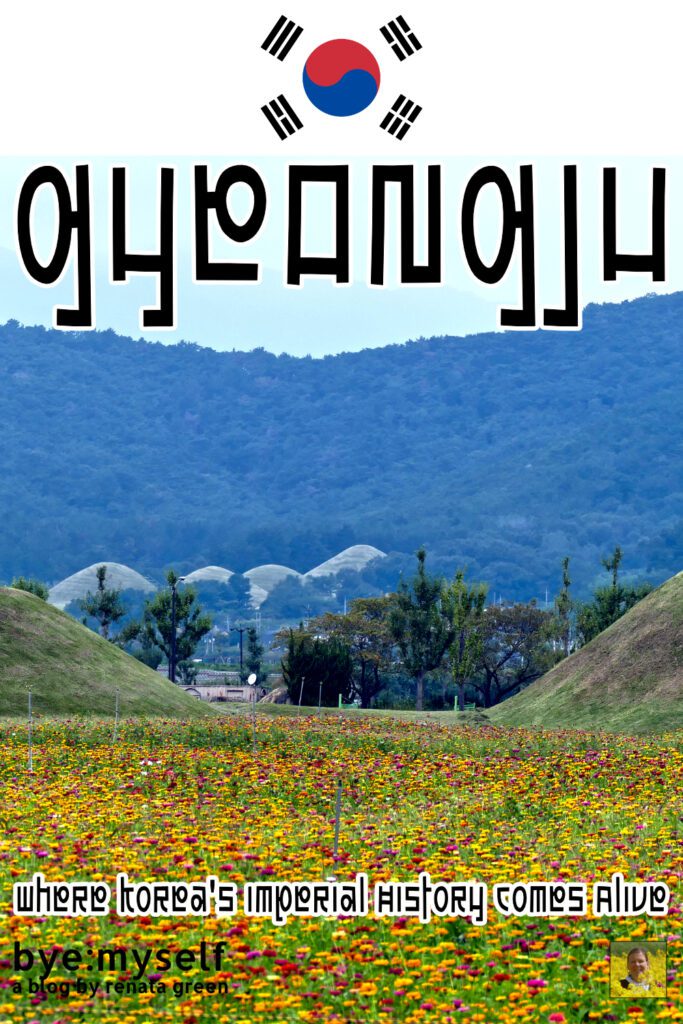
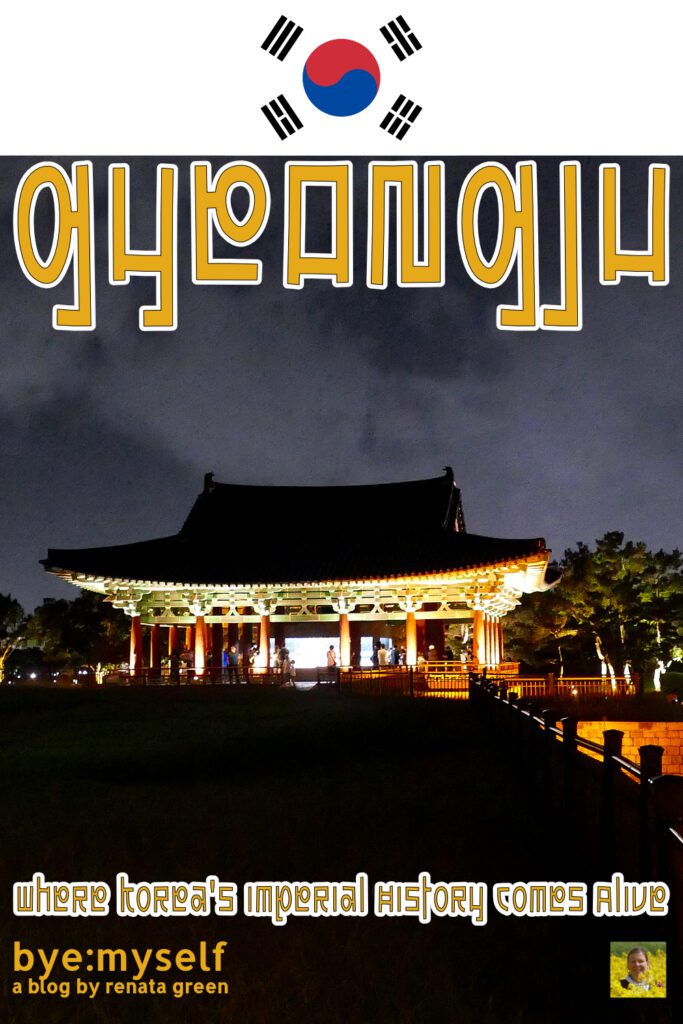

Note: I’ve thoroughly completed, edited, and updated this post in August 2025.
Did You Enjoy This Post? Then You Might Like Also These:
GYEONGJU: Two Days in the City Where Korea’s Imperial History Comes Alive
Best Things to Do in SEOUL: The Must-Dos And the Hidden Gems
The Perfect Itinerary for Three Days in BUSAN
Stroll the Fortress Wall of SUWON
Why the City of ULSAN is Absolutely Worth a Visit
INCHEON – Best Things to Do in Korea’s Only Chinatown
Individual Solo Trip to KOREA – All Your Questions Answered
Green Tea Plantations Around BOSEONG: Totally My Cup Of Tea!
* This is an affiliate link. Hence, If you book through this page, not only do you get the best deal. I also get a small commission that helps me run this blog. Thank you so much for supporting me!


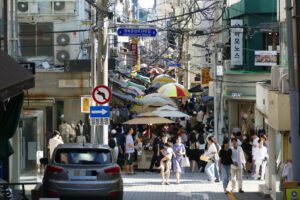


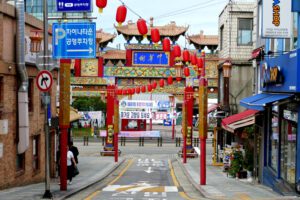


Your travel guides on South Korea are extremely helpful to me. Thank you for all your thorough work!
Thank you for letting me know – glad I can help! Safe travels!!
Your article on spending two days in Gyeongju is a fantastic read! I was particularly impressed with how you explored the Daereungwon Tomb Complex and Cheomseongdae Observatory, showcasing the city’s rich historical heritage. Your experiences in the cultural and culinary scene, especially the artisan bakeries, add a delightful dimension to the journey. This guide is a great resource for anyone planning a visit to Gyeongju.
Thank you, Agnes, I sure hope that my post gives other visitors some ideas of which activity to choose when in Gyeongju 🙂
I would love to visit this place one day! It really looks incredible and is somewhere completely new to me. I’d like to think that when I leave this earth one day my resting place will be as beautiful as the land surrounding the tombs. I’m enamored by the colors of the temple, and the souffle looks like something I’d eat in 2 seconds! Definitely on my list.
Yes, but if you want a tomb like this, you’ll have to bring a crown and lots of other gems with you; I don’t know if that’s an option 😉
And yes, the souffle was amazing. As I had to wait for half an hour since they prepare it from scratch, I took my time enjoying it, though 😀
You saw so many interesting places and things on your visit to South Korea. So I was interested to read why you said we must visit Gyeongju and to understand why it bore the nickname of Museum Without Walls. But when I learned about all the amazing historical treasures found around the different areas in the city I understood. I am not sure we would fall into either of the typical visitor groups. We would enjoy learning the history but the interesting sights would draw us as well. I can certainly see that the few days we had in South Korea was totally not enough! South Korea and Gyeongju deserve to be on the travel planning board.
Linda, I spent three weeks there, and my bucket list for South Korea is still kilometers long!